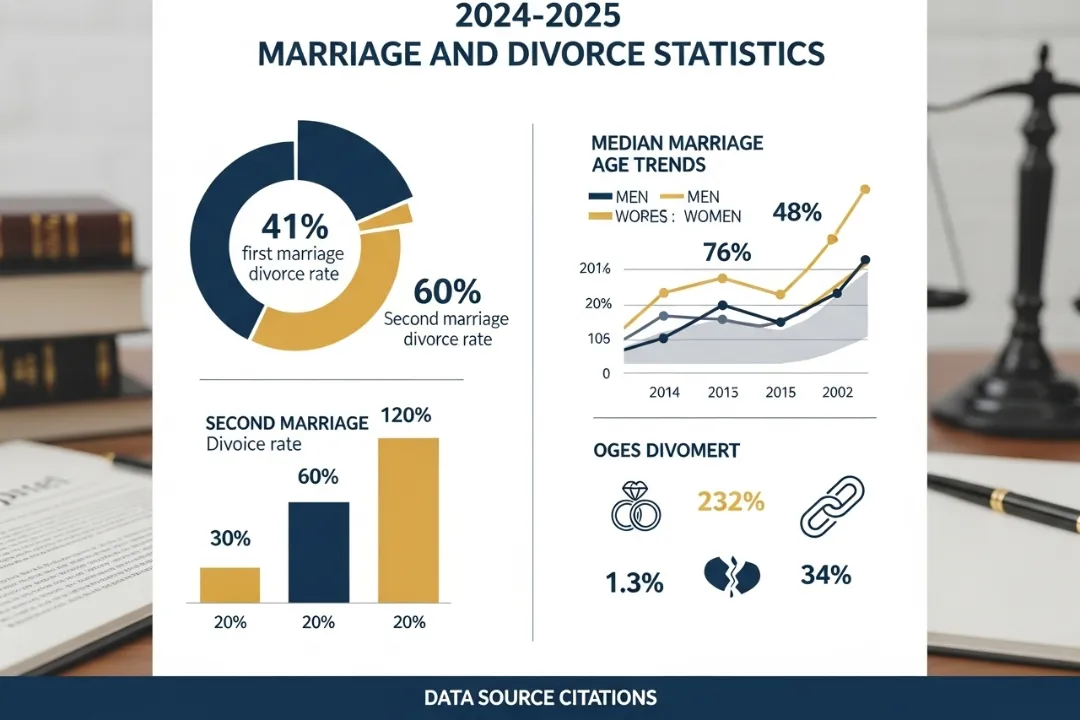When clients walk into my family law office and utter the phrase “please marry me with divorce in mind,” they’re not being pessimistic or unromantic—they’re being remarkably practical about modern marriage realities. After three decades of practicing family law and witnessing countless relationships dissolve in courtrooms across America, I can confidently say that couples who enter marriage with clear-eyed awareness of potential dissolution are far more likely to protect themselves, their children, and their financial futures than those who rely solely on romantic optimism.
The concept of “please marry me with divorce in mind” represents a fundamental shift in how modern couples approach marriage in 2025. Recent statistics show that approximately 41% of first marriages end in divorce, with second marriages facing a 60% divorce rate and third marriages reaching 73%. These sobering numbers aren’t meant to discourage marriage but rather to encourage intelligent preparation for life’s uncertainties. When couples embrace the “please marry me with divorce in mind” philosophy, they’re acknowledging that love alone cannot guarantee marital success and that practical planning serves as insurance for their emotional and financial well-being.
The traditional fairy-tale approach to marriage—where couples assume their love will conquer all obstacles—has proven insufficient in our complex modern world. Economic pressures, changing gender roles, career demands, and evolving social expectations create challenges that previous generations rarely faced. “Please marry me with divorce in mind” isn’t about expecting failure; it’s about preparing for success by addressing potential conflicts before they become relationship-ending crises. This approach allows couples to establish clear boundaries, expectations, and protections that can actually strengthen their marriage while providing security if circumstances change.
Modern family law has evolved to support couples who embrace the “please marry me with divorce in mind” mindset through various legal instruments including prenuptial agreements, postnuptial agreements, and comprehensive financial planning strategies. These tools don’t predict doom but rather provide structure and clarity that can prevent the bitter disputes I witness daily in divorce court. When couples plan thoughtfully for various life scenarios, they create frameworks for communication and decision-making that serve them well throughout their marriage, whether it lasts five years or fifty.
Understanding the Modern Marriage Landscape and “Please Marry Me With Divorce in Mind”
The landscape of American marriage has transformed dramatically over the past several decades, making the “please marry me with divorce in mind” approach increasingly relevant and necessary. The median age for first marriages has climbed to 30.2 years for men and 28.6 years for women in 2024—a significant increase from 23.1 and 21.1 respectively in 1974. This delay in marriage timing means couples are entering unions with more established careers, significant personal assets, and clearer understanding of their individual goals and expectations.
“Please marry me with divorce in mind” reflects the reality that modern marriages face unprecedented complexities compared to previous generations. In 29% of marriages, both spouses earn roughly the same amount, while in 55% of marriages, husbands remain the primary breadwinner, and in 16% of marriages, wives bring home the bigger paycheck. These diverse financial arrangements require careful planning and clear agreements about money management, career priorities, and long-term financial goals—exactly the type of practical discussions that the “please marry me with divorce in mind” philosophy encourages.
The economic realities facing modern couples also support the wisdom of “please marry me with divorce in mind” planning. The average cost of divorce in 2024 ranges from $7,000 to $15,000, but this figure can increase significantly in high-conflict cases or those involving substantial assets. When couples address potential points of conflict through prenuptial agreements and clear financial planning before marriage, they can dramatically reduce both the emotional and financial costs of potential future dissolution while simultaneously creating frameworks for healthy communication during their marriage.

“Please marry me with divorce in mind” also acknowledges the changing nature of family structures in America. Gray divorce among individuals aged 50 and older has doubled since the 1990s, indicating that couples may face relationship challenges at any stage of life. Additionally, women initiate approximately 69% of divorces in heterosexual marriages, suggesting that traditional assumptions about marriage dynamics may no longer apply. These demographic shifts require couples to approach marriage with realistic expectations and comprehensive planning.
The “please marry me with divorce in mind” mindset becomes particularly crucial when considering remarriage statistics and blended family dynamics. Second and subsequent marriages face even higher divorce rates, partly due to the complexities of merging families, managing relationships with ex-spouses, and addressing the needs of children from previous relationships. Couples entering these situations who embrace “please marry me with divorce in mind” planning are far better equipped to navigate these challenges successfully while protecting all family members’ interests.
The Legal Framework Supporting “Please Marry Me With Divorce in Mind” Planning
Family law has evolved to provide comprehensive legal frameworks that support couples who embrace the “please marry me with divorce in mind” approach to marriage planning. These legal instruments acknowledge that thoughtful preparation for various life scenarios strengthens rather than weakens marital relationships by creating clear expectations and reducing sources of potential conflict. The most significant tool in this legal arsenal is the prenuptial agreement, which allows couples to customize their financial and legal arrangements according to their specific circumstances and values.
“Please marry me with divorce in mind” planning through prenuptial agreements has gained widespread acceptance across all income levels and demographics. 63% of Certified Divorce Financial Analyst professionals believe prenuptial agreements help reduce the likelihood of contentious court battles during divorce. These agreements allow couples to address property division, spousal support, inheritance rights, and debt responsibility before emotions run high and legal bills accumulate. Far from being pessimistic, prenuptial agreements represent optimistic planning that prioritizes fairness and mutual respect.

The legal validity of “please marry me with divorce in mind” planning depends on proper execution and adherence to state-specific requirements. Most states require both parties to have independent legal counsel when creating prenuptial agreements, ensuring that both individuals understand their rights and responsibilities. Full financial disclosure is mandatory, and agreements must be executed voluntarily without coercion or duress. Courts will not enforce agreements that are unconscionable or that attempt to waive child support obligations, as child welfare always takes precedence over parental agreements.
“Please marry me with divorce in mind” planning can also include postnuptial agreements for couples who marry first and address these issues later. These agreements serve similar functions to prenuptials but are executed after marriage, often in response to changed circumstances such as inheritance, business ventures, or career changes. Postnuptial agreements can be particularly valuable for couples who want to clarify their arrangements after experiencing life changes that affect their financial or family dynamics.
The “please marry me with divorce in mind” approach extends beyond formal legal agreements to encompass comprehensive estate planning, insurance coverage, and financial management strategies. Couples who embrace this mindset typically create wills, trusts, and healthcare directives that reflect their married status while protecting individual interests. They also coordinate insurance coverage, beneficiary designations, and retirement planning to ensure both partners are protected regardless of what the future holds.
Financial Planning and the “Please Marry Me With Divorce in Mind” Philosophy
Financial planning represents perhaps the most crucial aspect of “please marry me with divorce in mind” preparation, as money-related conflicts rank among the leading causes of divorce in American marriages. Poor communication, infidelity, and financial disagreements constitute the top reasons couples cite for separation, making proactive financial planning essential for both marriage success and divorce protection. When couples address financial expectations, goals, and responsibilities before marriage, they create frameworks for ongoing communication and decision-making that strengthen their relationship.
“Please marry me with divorce in mind” financial planning begins with complete transparency about each partner’s financial situation, including assets, debts, income, and financial obligations. This disclosure process often reveals differences in financial values, spending habits, and long-term goals that couples must address for successful marriage. Whether or not couples ultimately divorce, these conversations about money provide essential foundations for joint financial decision-making throughout their marriage and help prevent misunderstandings that can escalate into serious conflicts.

The “please marry me with divorce in mind” approach requires couples to address how they will manage money during marriage and how assets would be divided if the marriage ends. Community property states like Arizona, California, Texas, and Washington automatically split marital assets 50/50 in divorce, while equitable distribution states consider various factors when dividing property. Couples who understand their state’s default rules can make informed decisions about whether prenuptial agreements would serve their interests.
“Please marry me with divorce in mind” financial planning also encompasses protection of pre-marital assets and inheritance rights. Individuals who own businesses, real estate, or substantial investments before marriage can use prenuptial agreements to ensure these assets remain separate property. Similarly, couples can address how inheritances, gifts, and family trusts will be treated during marriage and in potential divorce proceedings. This planning protects family wealth while avoiding conflicts that could damage relationships with extended family members.
The “please marry me with divorce in mind” philosophy extends to career and retirement planning, particularly when one spouse may sacrifice career advancement for family responsibilities. Prenuptial agreements can address compensation for career sacrifices, ensure adequate spousal support if the marriage ends, and protect retirement benefits accumulated during marriage. These provisions acknowledge the economic realities of modern marriage while providing security for both partners regardless of how their relationship evolves.
Child-Related Considerations in “Please Marry Me With Divorce in Mind” Planning
When couples embrace “please marry me with divorce in mind” planning, addressing child-related issues becomes particularly complex but essential, especially for second marriages and blended families. While prenuptial and postnuptial agreements cannot predetermine child custody or support arrangements—as courts always prioritize children’s best interests—couples can address related financial and logistical concerns that affect family dynamics and stability.
“Please marry me with divorce in mind” planning for blended families often focuses on protecting children from previous relationships while ensuring fair treatment of any future children. Prenuptial agreements can establish inheritance rights for existing children, ensure continued financial support for previous family obligations, and clarify how new marital assets will affect existing child support or educational commitments. These provisions provide security for children while allowing new spouses to enter marriage with clear understanding of existing responsibilities.
The “please marry me with divorce in mind” approach acknowledges that custody arrangements and parenting time decisions will be based on children’s best interests at the time of any future divorce, not on advance agreements between parents. However, couples can address related financial issues such as private school tuition, college expenses, healthcare costs, and extracurricular activities. These discussions help couples understand each other’s parenting values and financial priorities while creating frameworks for future co-parenting decisions.

“Please marry me with divorce in mind” planning becomes particularly important when one spouse adopts the other’s children or when couples plan to have children together after bringing existing children into their blended family. Legal adoption creates permanent relationships that continue regardless of divorce, while stepparent relationships may end if the marriage dissolves. Couples who understand these legal realities can make informed decisions about adoption timing and create appropriate financial protections for all children involved.
The “please marry me with divorce in mind” philosophy also addresses practical parenting concerns such as decision-making authority for stepchildren, communication with ex-spouses, and integration of different family traditions and rules. While these issues cannot be resolved through legal agreements alone, couples who discuss these topics before marriage are better prepared to handle conflicts and maintain child-focused priorities if their marriage ends.
“Please marry me with divorce in mind” planning recognizes that children’s needs and circumstances change over time, requiring ongoing flexibility and communication between parents. Couples who establish healthy communication patterns and conflict resolution strategies during marriage are more likely to maintain effective co-parenting relationships if they divorce, ultimately benefiting their children’s emotional and psychological well-being.
Estate Planning and the “Please Marry Me With Divorce in Mind” Approach
Estate planning represents a critical component of “please marry me with divorce in mind” preparation that couples often overlook in their focus on potential divorce scenarios. However, comprehensive estate planning protects couples against death, disability, and divorce while ensuring their wishes are honored regardless of what the future holds. When couples integrate estate planning with prenuptial agreements and financial planning, they create robust protection for themselves, their children, and their extended families.
“Please marry me with divorce in mind” estate planning begins with updating wills, trusts, and beneficiary designations to reflect married status while preserving individual inheritance intentions. Many people inadvertently disinherit children from previous relationships by failing to update estate planning documents after remarriage. Careful planning ensures that existing children receive intended inheritances while providing appropriate protection for new spouses and any future children.
The “please marry me with divorce in mind” approach requires couples to address healthcare decision-making authority and end-of-life care preferences through healthcare powers of attorney, living wills, and advanced healthcare directives. These documents ensure that spouses can make medical decisions for each other while respecting individual values and wishes. Without proper documentation, unmarried partners or family members might lack authority to make crucial healthcare decisions during emergencies.
“Please marry me with divorce in mind” estate planning also encompasses disability planning through financial powers of attorney and disability insurance coverage. These tools ensure that couples can manage each other’s affairs if disability prevents independent decision-making while protecting individual assets and financial interests. Disability planning becomes particularly important when couples have significant age differences or when one spouse has health concerns that could affect their ability to work or manage finances.
The “please marry me with divorce in mind” philosophy extends to tax planning and wealth transfer strategies that optimize couples’ financial positions during marriage while preserving flexibility for potential future changes. This planning might include establishing trusts for children from previous relationships, optimizing gift and estate tax strategies, and coordinating retirement account beneficiaries. Effective planning ensures that couples maximize tax benefits during marriage while maintaining appropriate protections for individual and family interests.
“Please marry me with divorce in mind” estate planning recognizes that family circumstances and relationships may change over time, requiring regular review and updates of estate planning documents. Couples who establish annual review processes and maintain open communication about their evolving wishes are better prepared to adapt their plans as their lives and families change.
Common Misconceptions About “Please Marry Me With Divorce in Mind” Planning
Despite growing acceptance of “please marry me with divorce in mind” planning, many couples still harbor misconceptions about prenuptial agreements and proactive marriage planning that can prevent them from accessing valuable protections. Understanding and addressing these misconceptions helps couples make informed decisions about their relationships and legal planning based on facts rather than outdated stereotypes or romantic ideals that may not serve their practical needs.
One persistent misconception suggests that “please marry me with divorce in mind” planning indicates lack of trust or commitment to the marriage. In reality, couples who engage in comprehensive planning demonstrate remarkable trust by sharing complete financial information and discussing difficult topics openly and honestly. This transparency creates stronger foundations for marriage by eliminating financial secrets and establishing clear expectations about major life decisions. Rather than undermining trust, “please marry me with divorce in mind” planning builds trust through honest communication and mutual respect.

Another common misconception portrays “please marry me with divorce in mind” planning as only necessary for wealthy individuals or celebrities with substantial assets to protect. However, prenuptial agreements are increasingly common among all income groups, with 41% of Gen Z and 47% of millennial respondents who are engaged or married entering prenuptial agreements. These agreements benefit anyone with assets, debts, career plans, or family obligations that they want to protect or clarify.
Some couples resist “please marry me with divorce in mind” planning because they believe discussing divorce scenarios will create negative energy or manifest relationship problems. However, research consistently shows that couples who communicate openly about difficult topics, including potential relationship challenges, develop stronger problem-solving skills and more resilient relationships. The ability to discuss uncomfortable topics respectfully and constructively actually strengthens marriages by building communication skills and mutual understanding.
The misconception that “please marry me with divorce in mind” planning focuses only on divorce scenarios overlooks the many benefits these strategies provide during successful marriages. Prenuptial agreements clarify financial responsibilities and decision-making authority, estate planning protects against death and disability, and comprehensive planning provides frameworks for major life decisions throughout marriage. These tools serve couples well regardless of whether their marriages end in divorce, death, or golden anniversary celebrations.
“Please marry me with divorce in mind” planning also faces misconceptions about enforceability and effectiveness. Some couples avoid prenuptial agreements because they’ve heard that courts don’t enforce them or that they can be easily challenged. While improperly drafted or unfair agreements may face legal challenges, properly executed prenuptial agreements with independent counsel, full disclosure, and reasonable terms are generally upheld by courts. Working with experienced family law attorneys ensures that agreements meet legal requirements and accomplish couples’ objectives.
The Role of Professional Guidance in “Please Marry Me With Divorce in Mind” Planning
Professional guidance plays an essential role in effective “please marry me with divorce in mind” planning, as the legal, financial, and emotional complexities involved require expertise that most couples don’t possess independently. Family law attorneys, financial planners, estate planning attorneys, and mental health professionals each contribute specialized knowledge that helps couples create comprehensive protection strategies while strengthening their relationships through improved communication and planning skills.
“Please marry me with divorce in mind” planning typically begins with consultations with experienced family law attorneys who can explain state-specific laws, discuss available options, and help couples understand how different planning strategies might affect their particular circumstances. Each partner should have independent legal counsel when creating prenuptial agreements to ensure that both individuals understand their rights and receive proper representation of their interests.
Financial advisors contribute crucial expertise to “please marry me with divorce in mind” planning by helping couples understand the long-term implications of various financial arrangements and planning strategies. These professionals can model different scenarios, explain tax implications, and recommend strategies for protecting and growing wealth during marriage while maintaining appropriate protections for potential future changes. Financial advisors also help couples coordinate their planning with existing investments, retirement accounts, and insurance coverage.
“Please marry me with divorce in mind” planning often benefits from estate planning attorneys who specialize in wills, trusts, and wealth transfer strategies. These professionals ensure that prenuptial agreements integrate properly with estate planning documents and that couples’ wishes will be honored regardless of whether their marriages end in divorce or death. Estate planning attorneys also address complex family dynamics and inheritance issues that can affect marital relationships.
Mental health professionals, including therapists and counselors who specialize in premarital counseling, can help couples navigate the emotional aspects of “please marry me with divorce in mind” planning. These discussions can trigger anxiety, fear, or conflict that requires professional support to address constructively. Couples who work with qualified professionals often emerge from the planning process with stronger communication skills and deeper understanding of each other’s values and priorities.
“Please marry me with divorce in mind” planning requires ongoing professional support as couples’ lives and circumstances change over time. Regular reviews with legal and financial professionals help ensure that planning documents remain current and effective while identifying new opportunities for protection and optimization. Couples who maintain professional relationships throughout their marriages are better prepared to address challenges and adapt their planning as needed.
Disclaimer
Legal Disclaimer: The information provided in this article is for educational and informational purposes only and should not be construed as legal advice. Laws vary by jurisdiction and individual circumstances. Always consult with a qualified attorney or legal professional for advice regarding your specific situation. ChoiceWisely.com is an informational blog website and does not provide legal services, professional advice, or consultation services. This content is not a substitute for professional legal counsel. For more information, please visit https://choicewisely.com/disclaimer/.
Conclusion: Embracing “Please Marry Me With Divorce in Mind” as Modern Marriage Wisdom
The phrase “please marry me with divorce in mind” may sound unromantic to traditionalists, but it represents the height of modern relationship wisdom and practical love in action. After witnessing countless couples struggle through bitter divorces that could have been prevented or minimized through proper planning, I can confidently say that couples who embrace this philosophy are far more likely to protect their emotional and financial well-being while building stronger, more communicative marriages.
“Please marry me with divorce in mind” isn’t about expecting failure or planning for the end of love—it’s about loving someone enough to protect them and your relationship through honest communication, realistic planning, and comprehensive protection strategies. The couples who sit in my office discussing prenuptial agreements and financial planning are investing in their marriages just as surely as couples who invest in wedding ceremonies and honeymoons. They’re simply extending their investment timeline beyond the wedding day to encompass their entire shared future.
The wisdom of “please marry me with divorce in mind” planning becomes even more apparent when we consider the alternative scenarios I witness daily in family court. Couples who entered marriage with nothing but love and optimism often find themselves in bitter disputes over money, property, and children that could have been resolved through advance planning. The financial and emotional costs of contentious divorce proceedings far exceed the modest investment required for comprehensive prenuptial planning, making “please marry me with divorce in mind” one of the most cost-effective relationship investments couples can make.
Modern marriage requires modern planning strategies that acknowledge contemporary realities while preserving the love, commitment, and partnership that make marriage meaningful. “Please marry me with divorce in mind” planning provides couples with tools for navigation life’s uncertainties while building communication skills and mutual understanding that strengthen their relationships. For more informational content about legal and financial planning topics, visit ChoiceWisely.com to explore comprehensive guides and educational resources.
Taking Action: Implementing “Please Marry Me With Divorce in Mind” Planning
Don’t wait until relationship stress or life changes force difficult conversations about money, assets, and future planning. The time to implement “please marry me with divorce in mind” strategies is when your relationship is strong and you can approach these topics with love, respect, and mutual commitment to each other’s well-being. Whether you’re engaged, newly married, or celebrating decades together, comprehensive planning can protect and strengthen your relationship while providing security for your future.
Professional guidance makes “please marry me with divorce in mind” planning more effective and less stressful for couples who want to protect their relationships and their individual interests. Experienced family law attorneys, financial planners, and estate planning professionals can help you understand your options and create strategies tailored to your specific circumstances and goals. For additional educational content and informational resources about family law and financial planning topics, visit ChoiceWisely.com/work-with-us/ to explore more comprehensive guides and articles that can help you build stronger, more secure relationships.
Frequently Ask Questions?
Is it normal to think about divorce in a marriage?
Yes, it’s completely normal to think about divorce in a marriage. Research shows that approximately 41% of first marriages end in divorce, indicating that marital dissatisfaction is common. Occasional thoughts about divorce don’t necessarily indicate a failing marriage, but persistent thoughts may signal underlying issues that need attention through communication or counseling.
How to survive a divorce after 20 years of marriage?
Surviving a divorce after 20 years requires focusing on self-care, seeking professional support, establishing new routines, and rebuilding your social network. Prioritize your physical and mental health, consider therapy, lean on friends and family, and take time to rediscover your individual identity. Financial planning and legal guidance are also crucial for long-term stability.
What is a silent divorce?
A silent divorce refers to couples who remain legally married but are emotionally disconnected and live separate lives. They coexist like roommates rather than romantic partners, with minimal communication, no physical intimacy, and separate social activities. This emotional separation occurs without formal legal proceedings, often for financial or practical reasons.
What is grey divorce?
Grey divorce refers to divorce among couples aged 50 and older, representing a growing trend that has more than doubled since 1990. Currently, 36% of all divorces involve people over 50. These divorces often involve complex financial considerations including retirement accounts, social security benefits, and health insurance coverage, with significant economic impacts especially for women.
What is a ghost divorce?
A ghost divorce typically refers to a divorce that occurs without one spouse’s knowledge or involvement, often through default proceedings when one party fails to respond to divorce papers. This can happen when a spouse disappears, cannot be located, or refuses to participate in the divorce process. Courts may proceed with the divorce after proper legal notice attempts.
What is a green divorce?
A green divorce focuses on environmentally conscious and sustainable practices during the divorce process. This includes reducing paper waste through digital documentation, choosing mediation over litigation to reduce environmental impact, fairly dividing eco-friendly assets, and making environmentally responsible decisions about shared property and resources.
What is sleep divorce?
Sleep divorce refers to couples who choose to sleep in separate beds or bedrooms to improve sleep quality while remaining happily married. About 35% of Americans occasionally or consistently practice sleep divorce due to snoring, different sleep schedules, or personal space preferences. This trend is most common among millennials at 43% compared to 22% of baby boomers.
Who regrets divorce the most?
Men regret divorce more than women, with studies showing 32% of men versus 27% of women experience divorce regret. Research indicates 73% of women report no regret over their divorce compared to 61% of men. Men tend to struggle more with loneliness, subsequent relationship failures, and the loss of their primary emotional confidante.
What is the hardest stage of divorce?
The hardest stage of divorce is typically the initial separation and legal proceedings phase, which involves the most emotional turmoil, uncertainty, and major life changes. This stage includes telling children, dividing assets, establishing new living arrangements, and navigating the legal system. The period immediately following divorce papers being filed is often considered the most challenging.
Is it worth getting divorced at 50?
Getting divorced at 50 can be worth it if you’re in an unhappy or unhealthy marriage, but it requires careful consideration of financial implications. Grey divorce often results in a 50% decrease in wealth and significantly impacts retirement planning. However, many people report improved well-being and life satisfaction after leaving unsatisfying marriages, even later in life.
When to stop trying and get a divorce?
Consider divorce when you’ve exhausted efforts to repair the relationship, including counseling, and fundamental issues remain unresolved. Warning signs include persistent unhappiness, loss of respect, continuous conflict, emotional or physical abuse, addiction, infidelity, or when you no longer share common goals and values. If you find yourself in a silent divorce situation, it may be time to make formal decisions.
Will husband regret divorce?
Many husbands do regret divorce, with 32% of men reporting divorce regret compared to 27% of women. Men often regret divorce because they still love their ex-wife, struggle with subsequent relationships, miss the emotional security of marriage, or realize they could have tried harder to save the relationship. The regret is often stronger when men initiated the divorce.
Is separation a better first step?
Separation can be a better first step than immediate divorce as it provides time for reflection, allows couples to experience life apart, and can lead to reconciliation in some cases. Legal separation offers some benefits of divorce while keeping options open. However, separation should have clear boundaries and timeframes to avoid indefinite limbo that prevents both parties from moving forward.
